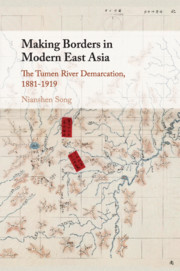Crossref Citations
This Book has been
cited by the following publications. This list is generated based on data provided by Crossref.
Cathcart, Adam
and
Winstanley-Chesters, Robert
2018.
German Studies of Koreans in Manchuria: Gustav Fochler-Hauke and the Influence of Karl Haushofer’s National Socialist Geopolitics.
European Journal of Korean Studies,
p.
131.
Grosser, Pierre
2018.
Le retour des populismes.
p.
240.
Wang, Sixiang
2019.
Compiling Diplomacy: Record-Keeping and Archival Practices in Chosŏn Korea.
Journal of Korean Studies,
Vol. 24,
Issue. 2,
p.
255.
Corff, Oliver
2019.
Nations and Rivers: Their Status and Name in the Qingshi Gaoreflections on the Draft History of Qing as a Source.
Vol. 53,
Issue. ,
p.
21.
Seeley, Joseph A.
2020.
Reeds, river islands, and inter-imperial conflict on the early twentieth-century Sino-Korean border.
Water History,
Vol. 12,
Issue. 3,
p.
373.
Lu, Xiaoxuan
2021.
My Love from the Mountain: Contingent bordering processes at Mount Changbai/Baekdu.
Area,
Vol. 53,
Issue. 3,
p.
511.
Kramer, Derek
2022.
“We Go on Our Own Boats!”: Korean Migrants and the Politics of Transportation Infrastructure in the Japanese Empire.
International Review of Social History,
Vol. 67,
Issue. 2,
p.
295.
Shannon, Kelly
2023.
LU, Xiaoxuan. 2023. Shifting Sands: Landscape, Memory, and Commodities in China’s Contemporary Borderlands. Austin: University of Texas Pres.
China Perspectives,
p.
87.
Seeley, Joseph
2023.
Cattle, Viral Invasions, and State-Society Relations in a Colonial Korean Borderland.
Journal of Korean Studies,
Vol. 28,
Issue. 1,
p.
5.
Leung, Shuk Man
2023.
Chinese Settler-Colonialism and the Borderless National Imagination in Lü Sheng’sA Madman’s Dream.
Asian Studies Review,
Vol. 47,
Issue. 3,
p.
500.
2023.
Borderland Dreams.
p.
52.
2023.
Borderland Dreams.
p.
77.
2023.
Borderland Dreams.
p.
1.
Han, Sean S.
2023.
Informal diplomacy in Chosŏn Korea and new engagement with the West and Westernized Japan, 1873–1876.
Modern Asian Studies,
Vol. 57,
Issue. 1,
p.
252.
2023.
Borderland Dreams.
p.
100.
2023.
Borderland Dreams.
p.
187.
Wu, Shellen
2023.
The Profits of Nature: Colonial Development and the Quest for Resources in Nineteenth-Century China
.Peter B. Lavelle,
The Profits of Nature: Colonial Development and the Quest for Resources in Nineteenth-Century China
.New York, NY: Columbia University Press, 2020. Hardcover, $65, ISBN: 9780231194709.
.
East Asian Science, Technology and Society: An International Journal,
Vol. 17,
Issue. 4,
p.
537.
2023.
Borderland Dreams.
p.
150.
2023.
Borderland Dreams.
p.
123.
2023.
Borderland Dreams.
p.
177.





